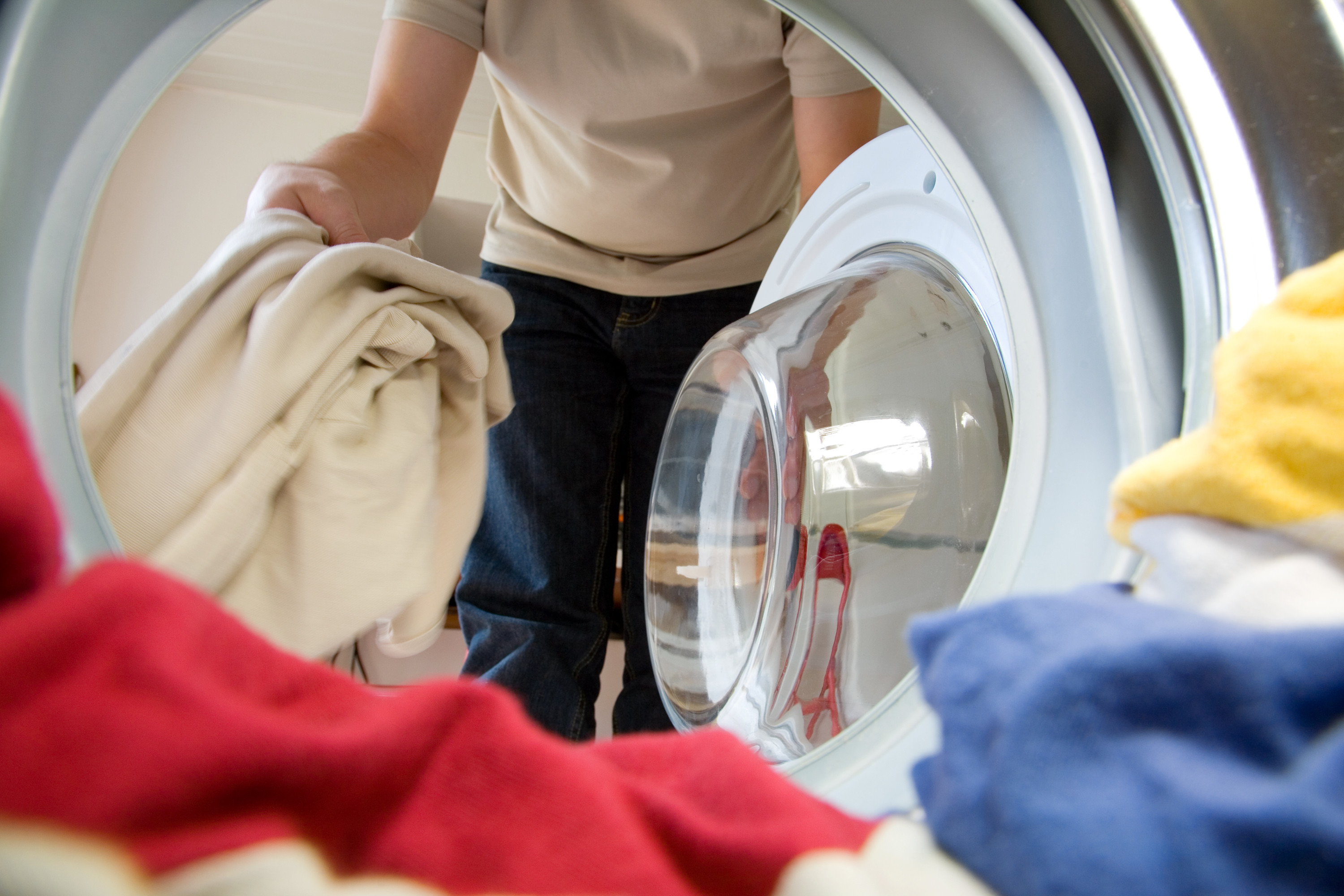
By Larry Erickson, Kannegiesser ETECH, Director of Software Development
Like any motivated employee, I often find myself engulfed in deep thought about a particular work problem. Normally, these times of deep thought manifest in typical ways of deep thinkers; 30-minute showers, missing a freeway exit, or staring at my wife’s dumbfounded expression as I realize she has asked me a question but I don’t know what it was.
If my passion for my job wasn’t annoying her enough already, I have really put myself in danger of sleeping on the couch with my latest venture. I have begun trying to optimize our home laundry system. I have found many correlations between a typical household laundry process and that of industrial laundry. Obviously, a much smaller scale, but surprisingly many of the same problems exist and similar efficiency solutions apply.
Don’t process what you don’t need
Households, like laundries, have daily requirements that must be met. On any given day, we may be running low on bath towels and kids pajamas, but have absolutely no need to wash my socks or any of my wife’s 30 pairs of jeans.
The other week, we were in the middle of doing laundry we didn’t really need and our son Oliver’s blanket got dirty. He calls it his “blue” and he has slept with it every night since birth. Our high-priority customer, Oliver, needed his specialty item blue blanket done by a very tight 8:00 pm deadline (his bedtime). If he didn’t get it, there would be one very upset customer. We couldn’t do his “blue” because our washer and dryers were backlogged with products we didn’t need.
The solution at home and in a laundry is found by gathering daily requirements and making intelligent decisions based upon them. For the past year, we have been spending eVue development time working with vendors to pull these daily requirements into our system. The results have been dramatic. The home and industrial laundry prove that gathering daily requirements is a critical piece to the optimization puzzle.
Don’t wash what you can’t finish
At home, we often start a load of laundry so late that we get tired and forget to throw it into the dryer. A chaotic morning, followed by a stressful work day, followed by kid’s nighttime activities can mean we leave the laundry in the washing machine wet for a day or two (or three!!). That laundry sitting wet for several days then leads to rewash, which is annoying, wasteful, and causes us to lose out on the opportunity cost of washing other clothes.
Machine downtime can have devastating effects on efficiency
 One Saturday, we had nothing to do and we hadn’t done laundry all week, so we thought it was a good opportunity to catch up. We were doing large loads and overfilled our dryer. When we do this, often our dryer door will open in the middle of a load, causing the dryer to stop. We didn’t notice this for at least two hours and, as a result, it devastated our overall pounds per hour for the day. We were never able to catch up after that. If only we had been alerted (eText alerts), machine downtime could have been reduced and our efficiency would have been minimally impacted.
One Saturday, we had nothing to do and we hadn’t done laundry all week, so we thought it was a good opportunity to catch up. We were doing large loads and overfilled our dryer. When we do this, often our dryer door will open in the middle of a load, causing the dryer to stop. We didn’t notice this for at least two hours and, as a result, it devastated our overall pounds per hour for the day. We were never able to catch up after that. If only we had been alerted (eText alerts), machine downtime could have been reduced and our efficiency would have been minimally impacted.
Every time you touch a piece of linen you must add value
Observing my wife fold and put away clothes is a painful process. From the dryer, she loads the clothes into a laundry basket (Touch 1). She then carries the laundry basket into our living room and unloads it onto the floor (Touch 2). She starts folding the items into two piles (Touch 3): one for each of our children. She then grabs the clothes and places them back in the laundry basket (Touch 4). Then she goes to our daughter’s room, unloads the clothes on the floor (Touch 5), then grabs those piles and places them into the dresser (Touch 6). Next, she goes to our son’s room for the same process (Touch 7 and 8). After watching this I asked her, “Do you realize that you handled that linen 8 times”? To which she responded, “Do you realize you’re disturbed and please stop following me around.”
I suggested to her a way in which she would only have to handle the linen 3 times. Whether or not she follows my advice remains to be seen.
Smartly designed automated laundries can eliminate touches in many ways such as cart dumpers, automatically opening slings, smart conveyor systems such as Vectura, and clean side monorail. Every time you touch a piece of linen, you must add value or you will not be as efficient as you could be.
Special care must be given to specialty items
If you want to make your significant other angry, shrink one of their “going-out” shirts. I have been married long enough to understand that while all my clothes can get washed at any temperature and thrown in the dryer; my wife’s clothes, especially her shirts, require special attention. I have lacked focus a few times over the years, shrinking or ruining some clothes, and paid a hefty price.
In the laundry industry, customers expect their linen to be held to higher standards. If a customer is staying at a $400 a night hotel, they don’t want to see wrinkles in their bed sheets. The laundry industry is working hard to adapt to these demands, or run the risk of losing important clients.
Trust me, after I wrecked my wife’s ‘peacock’ shirt I triple check every label to see if it says “dry clean only”.
Keep the clean side balanced and staffed to handle washing
Most people, my wife especially, have no problem washing clothes but have a hard time finishing them. Finishing is the harder task at home or at a laundry and takes many more resources. Staffing your finishing so it is balanced and can keep up with what is being produced is often a challenging task.
Our in-home laundry bottleneck is our clean side, and our clean side staff (my wife and I) cannot keep up with our washing equipment (30-pound Whirlpool). As our children get older, we can potentially double our clean side staff and may be able to, someday, keep up with our washing equipment.
As you can see, there are many similarities between large industrial laundries and a household laundry. Efficiency gains that can happen as the result of optimizing machines and processes, apply to both facilities.
Sometimes focusing on the simple cases like home laundry can highlight the big picture problems, and focusing on solving these problems in common-sense ways can lead to easy efficiency gains.
About the Author
 Larry Erickson is Director of Software Development for Kannegiesser-ETECH. He has been with the company for over 13 years and is the Lead Developer of the Kannegiesser-ETECH eVue software. Running in over 175 laundries, eVue makes laundry operations faster, smarter and more efficient. In his spare time, Larry applies those principles to his home laundry. An extreme optimist, Larry is bad at saying, “No” and has been nicknamed, Mr. Excitement.
Larry Erickson is Director of Software Development for Kannegiesser-ETECH. He has been with the company for over 13 years and is the Lead Developer of the Kannegiesser-ETECH eVue software. Running in over 175 laundries, eVue makes laundry operations faster, smarter and more efficient. In his spare time, Larry applies those principles to his home laundry. An extreme optimist, Larry is bad at saying, “No” and has been nicknamed, Mr. Excitement.
Image top right: (c)tilo – Can Stock Photo Inc
Image Center: (c) Bialasiewicz – Can Stock Photo Inc













